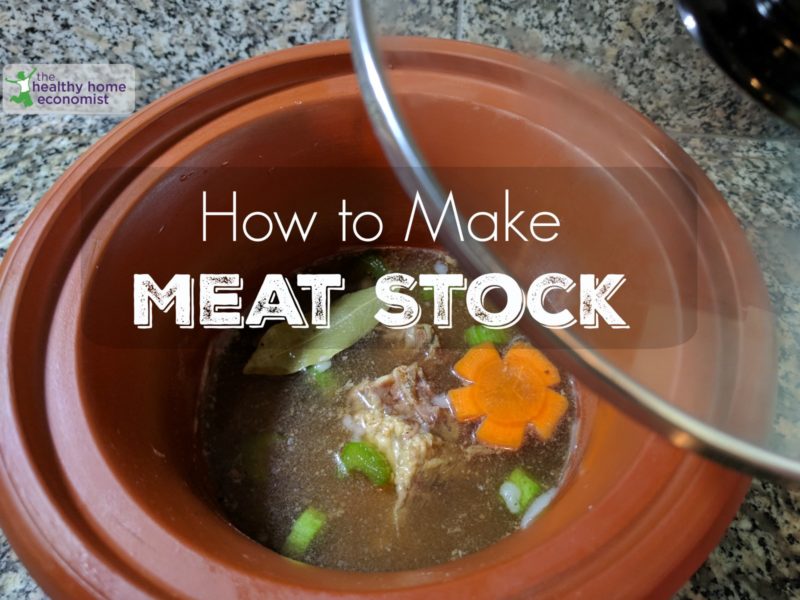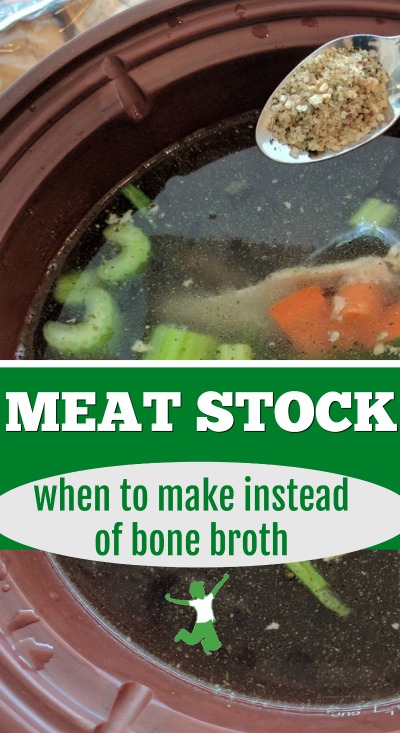Table of Contents[Hide][Show]

Properly prepared homemade broth is a foundational food for autoimmune healing diets such as GAPS, AIP, or the Specific Carbohydrate diet.
The GAPS protocol, for example, recommends a small cup of broth with every meal. This traditional food is the only cooked food that acts as a raw food when consumed. This is accomplished by the gelatin in the broth, which powerfully attracts digestive juices to itself. This, in turn, significantly enhances the nutrient absorption for all the other foods consumed with it.
Ironically, this most curative of foods is frequently not well tolerated by people with leaky gut – the very people who desperately need it! Fortunately, this intolerance only lasts a short period of time until gut-healing advances.
What to do in the interim since bone broth is such an important healing food? The answer is to make meat stock instead.
When Meat Stock is the Better Choice
The reason some individuals with leaky gut do not tolerate bone broth is is due to the beneficial natural glutamates that can sometimes trigger uncomfortable reactions. MSG is the synthetic, factory-produced version of glutamate. MSG is an excitotoxin, which means it damages or even kills neurons. Neurosurgeon Dr. Russell Blaylock MD lays out all the science in his eye-opening book Excitotoxins: The Taste that Kills.
While the natural glutamate in bone broth are not dangerous or equivalent in any way to concentrated, factory-produced MSG, they can nonetheless trigger similar symptoms in sensitive individuals. Yeast extract can do the same. Thus, anyone sensitive to MSG typically does much better with meat stock, which has little glutamate by comparison.
Others best served by stock instead of broth are children and adults who are autistic, those with ADD/ADHD, and/or people suffering from seizures or tics.
Another sign that bone broth is best replaced with meat stock is when uncomfortable die-off symptoms, as well as nervous system agitation occurs. These are signs that your digestive tract is not ready for bone broth. Use meat stock when symptoms such as diarrhea, vomiting, nausea, constipation, and skin eruptions or rashes develop. Making the transition gradually from stock to broth is advisable.
Storing Meat Stock
When you make meat stock as described in the recipe below, you will notice that a significant amount of fat forms with it. This fat is best left in the stock. When it cools, it will rise to the top and remain there. The fat forms a protective seal that prevents oxidation.
Refrigerated meat stock will last a week or more with that layer of fat on top. If you prefer to remove the fat to create a clarified meat stock, it is best to freeze it. No worries, as meat stock thaws beautifully.
This article on freezing stock or broth provides tips on the safe use of either plastic or glass for this purpose.
Homemade Meat Stock
The most significant difference between meat stock and bone broth is that stock is not cooked as long as broth. This results in some pros as well as cons.
Pros
First for the pros. Stock is just as rich in gelatin and beneficial detoxifying amino acids (like proline and glycine) as broth. These nutrients are pulled out of the meat and connective tissue during the first several hours of cooking. A lengthy simmer is not necessary.
Another pro is that the meat used to make stock doesn’t become tasteless as it does with a long-simmering broth. It is delicious and can be used alone or with any meat dish you wish.
Cons
Now for the cons. First, you will notice that stock is not quite as flavorful as long-simmering bone broth. This is due to the significant reduction in glutamate.
The savvy home chef can compensate by ensuring quality vegetables are simmered with the meat stock. While making bone broth doesn’t always require vegetables to achieve amazing flavor, meat stock definitely does. If you don’t have time to add veggies to your stock, check out this article on seasoning stock to ensure it is great tasting anyway.
I would recommend following the recipe below as closely as possible to ensure your stock tastes as flavorful as properly made broth. Using chicken feet is highly recommended as well (though an optional ingredient) to achieve higher levels of gelatin.
Avoid Stainless Steel
I recommend avoiding stainless steel pots and pressure cookers like the Instapot for making both meat stock and bone broth.
This is due to the very real potential for leaching heavy metals like nickel when acidic dishes are cooked. Enameled stockpots or the clay slow cookers like Vita-clay would be safer choices. This is especially important for those already suffering from heavy metal toxicity issues. This risk has been demonstrated by compelling scientific research.
How to Use
Meat stock is a wonderful base for soups and sauces just the same as broth.
Sipping it on its own in a mug is delicious and hugely beneficial too, especially when added to a meal of other cooked foods.

Homemade Meat Stock Recipe
Recipe for gelatin rich meat stock to be used instead of bone broth for those with leaky gut in the beginning stages of healing.
Ingredients
- 1 whole chicken preferably pastured
- 2-4 chicken feet optional
- 1-2 chicken heads optional
- 4 quarts filtered water
- 2 Tbl apple cider vinegar raw, packed in glass only
- 1-2 yellow onions medium, preferably organic
- 2-4 carrots preferably organic
- 3-4 celery stalks preferably organic
- 1 bay leaf
- 1-2 tsp sea salt
- 1 bunch parsley preferably organic
Instructions
-
Rinse chicken and optional feet with filtered water.
-
Cut whole chicken in half down the middle lengthwise. Place everything in the stockpot. Add remaining ingredients.
-
Fill pot with filtered water. Allow the pot and its contents to stand for 30 minutes, giving the raw apple cider vinegar time to draw minerals out of the bones. Bring to a boil. Reduce the heat to a simmer and cook for no more than 1 ½ to 2 hours.
-
Add parsley and sea salt during the last 10 minutes of cooking. Remove the chicken and other large parts. Debone and reserve the meat for eating. It will be delicious.
-
Strain the stock, cool to room temperature and then refrigerate or freeze.









Hi Sarah, This is very interesting!… I was giving my Son lots of bone broth. He is under assessment for ASD. Last November he started having seizures, I so hope I have not caused them. He is still having them. I have stopped the Bone Broth. Any advise would be grateful.
I would definitely switch to meat stock for a child on the spectrum.
You are right. See this investigation made by Natural News:
https://www.naturalnews.com/2017-10-07-bone-broth-protein-products-lab-tested-full-press-conference-video-released-detailing-the-toxic-chemicals-that-were-found.html
Is Dr. Axe bone broth protein powder a good alternative?
As mentioned in another comment, I do not recommend bone broth powders. They are overly processed and do not offer the benefits of homemade meat stock and bone broth. The convenience comes at a huge price and you don’t get the same health benefits anyway. I honestly don’t see any reason to buy it.
Hi Sarah,
I really love your articles!! I am taking them to heart and am following your advice on all things. I have a couple of questions. 1) If fat is good for us, why are we skimming the fat and straining the broth once it is finished cooking? Should we strain both broth and stock? When would we NOT want to strain? 2) I read in one of your articles to freeze broth in plastic containers. Is it OK to freeze in glass containers? Thank you!
Hi Nancy, the fat off stock is wonderful, but some folks prefer the stock less oily, which is why I mentioned clarified stock. It’s just a personal preference type of thing. Don’t skim if you don’t want to, but certainly if you do skim it off, don’t throw that fat out .. I should have suggested to put it in a container and reserve in the fridge for cooking veggies and such. Very nutritious fat! Yes, it’s fine to freeze in glass .. there is a linked article above that discusses tips for freezing in both plastic and glass safely if you want to take a look again.
Hi Sarah, how much of the meat stock should one consume a day? Have a quarter cup or so with each meal, as with the bone broth? Thanks! 🙂
A small cup (few ounces) of bone broth OR meat stock is recommended with every meal on the GAPS diet.
Does anyone know if organic bone broth protein powder is a healthy alternative?
I don’t recommend this product, as it dissolves in cold liquids which basically negates the enormous digestive benefits of the unprocessed gelatin you would get in meat stock. Not to mention the potential for toxic packaging issues. It is best to make meat broth yourself … it is just too important a food to rely on a factory processed product! Convenience usually comes with a price.
Hi Sarah, you mentioned how to store bone broth, I’ve been using the pressure canner is this okay?
Freezing would be far better for retaining nutrient value of the broth.
Great article!
Relating to heavy metal toxicity issues, is Instant Pot safe to use if apple cider vinegar is omitted from the meat broth recipe?
Yes, should be fine if you don’t use any vinegar. But then, the broth won’t be as beneficial.
Why is it better to drink meat stock rather than actually eat the meat you put in the meat stock? Wouldnt eating the meat give you more nutrients, protein, fats etc that will heal you?
There are bones in the meat stock too.
What are the times when using a VitaClay? Are there any other differences? Thank you.
Good question! Instead of an hour and a half, it usually takes about 2-3 hours in the Vita-Clay.